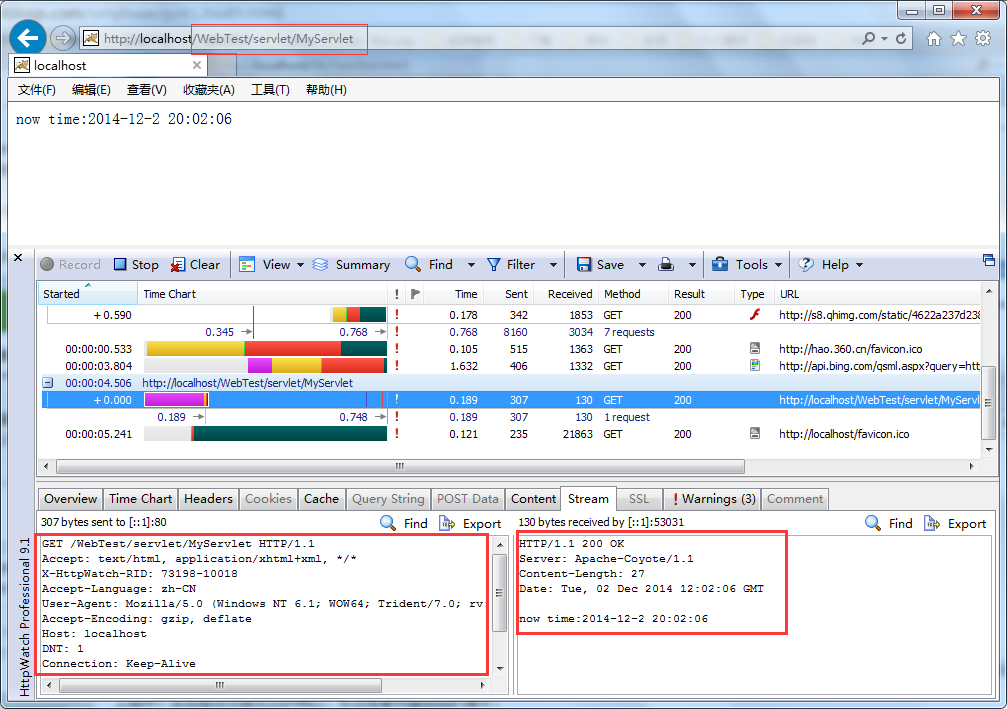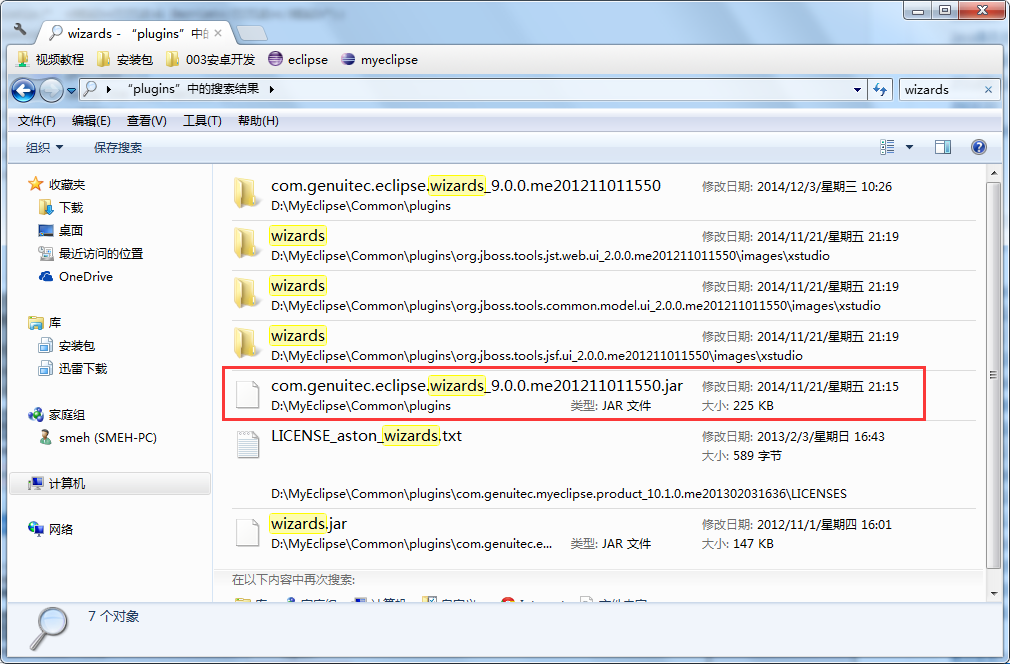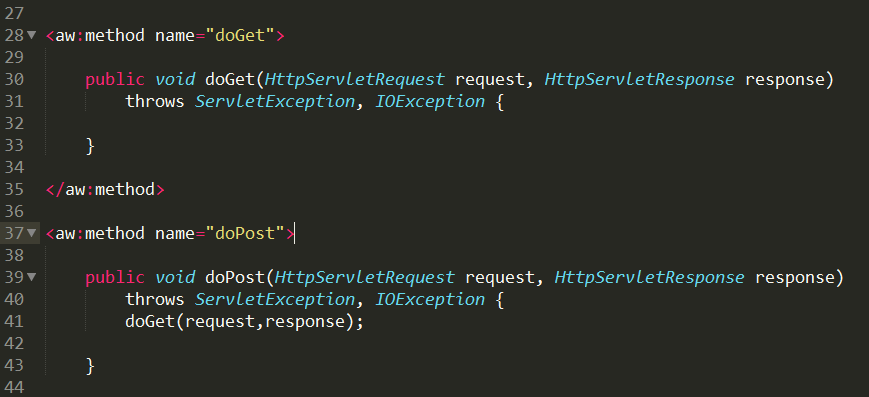JavaWeb学习之Servlet(二)----Servlet的生命周期、继承结构、修改Servlet模板
【声明】
欢迎转载,但请保留文章原始出处→_→
文章来源:http://www.cnblogs.com/smyhvae/p/4140466.html
一、http协议回顾:
在上一篇文章中:JavaWeb学习之Servlet(一)----MyEclipse及Tomcat的配置,我们通过在浏览器输入url,就能看到在MyEclipse中编写的Servlet资源,效果如下:

上图中,整个过程是这样的:浏览器中输入url后,会通过hosts文件/dns服务器解析为IP地址,进而找到对应ip地址的服务器。
在这期间,浏览器会通过http协议发出请求。服务器端收到请求后,做了下面这些事:
(1)分析出当前请求的是哪台虚拟主机:
- 查看Host请求头分析出访问的是哪台虚拟主机
- 如果没有Host请求头(在浏览器地址栏直接输入ip地址而不是url),则访问缺省虚拟主机
(2)分析当前请求访问的是当前虚拟主机的哪个Web应用:
- 从请求行中请求的资源部分来分析
(3)分析当前请求要访问的是这个Web应用的哪个资源:
- 从请求行的资源部分分析出访问的是哪个资源
(4)查找web.xml文件,查看有没有对应的虚拟路径,如果有则用这个虚拟路径对应的资源做响应

(5)服务器从response对象中获取之前写入的数据(这就是写在Servlet当中的java代码),组织成http响应消息发给浏览器。
注:第(5)句话便是本文要学习的重点。
二、Servet的运行过程及生命周期
Servlet程序是由WEB服务器调用,web服务器收到客户端的ServletWeb服务器首先检查是否已经装载并创建了该Servlet的实例对象。如果是,则直接执行第(4)步,否则,执行第(2)步。
访问请求后:
(1)装载并创建该Servlet的一个实例对象。
(2)调用Servlet实例对象的init()方法。
(3)创建一个用于封装HTTP请求消息的HttpServletRequest对象和一个代表HTTP响应消息的HttpServletResponse对象,然后调用Servlet的service()方法并将请求和响应对象作为参数传递进去。
(4)WEB应用程序被停止或重新启动之前,Servlet引擎将卸载Servlet,并在卸载之前调用Servlet的destroy()方法。
Servet的生命周期:
Servlet 的生命周期定义了一个Servlet如何被加载、初始化,以及它怎样接收请求、响应请求、提供服务。
生命周期如下:
- (1)通常情况下,服务器会在Servlet第一次被调用时创建该Servlet类的实例对象(servlet出生),创建出对象后立即调用init()方法做初始化操作;
- (2)一旦被创建出来,该Servlet实例就会驻留在内存中,为后续对这个Servlet的请求做服务,每次对这个Servlet的访问都会导致Servlet中Service方法执行;
- (3)当web应用被移除容器或者关闭服务器时,随着web应用的销毁,Servlet也会被销毁(servlet死亡)。在销毁之前服务器会调用Servlet的destroy方法做一些善后的工作。
有3个方法代表了Servlet的生命周期:
- init方法,负责初始化Servlet对象。
- service方法,负责响应客户的请求(调用doGet或doPost等方法)。
- destroy方法,当Servlet对象退出生命周期时,负责释放占用的资源。
注:在Servlet的整个生命周期内,Servlet的init方法只有在servlet被创建时被调用一次,每次对这个Servlet的访问都会导致Servlet中Service方法执行。
例如:现在浏览器连续访问Servlet 10次,内存中只有一个Sevlet对象。Servlet对象由服务器创建(创建一次),request和response由Servlet容器创建(创建10次)
来看一段代码:
package com.vae.servlet;
import java.io.IOException;
import java.io.PrintWriter;
import javax.servlet.ServletException;
import javax.servlet.http.HttpServlet;
import javax.servlet.http.HttpServletRequest;
import javax.servlet.http.HttpServletResponse;
//一般实现一个Servlet,只要继承HttpServlet类即可
public class MyServlet extends HttpServlet {
//Servlet初始化时调用的方法
@Override
public void init() throws ServletException {
super.init();
System.out.println("init....");
} //Servlet被销毁时调用的方法
@Override
public void destroy() {
super.destroy();
System.out.println("destroy...");
}
//-------doGet/doPost 核心的业务处理方法(由service方法来调用)------------
@Override
protected void doGet(HttpServletRequest req, HttpServletResponse resp)
throws ServletException, IOException {
//super.doGet(req, resp);
doPost(req, resp);
System.out.println("do service...");
} @Override
protected void doPost(HttpServletRequest req, HttpServletResponse resp)
throws ServletException, IOException {
//super.doPost(req, resp);
}
}
运行程序,输入url,此时,一按回车,马上就会在后台打出日志:

然后连续刷新三次网页,日志如下:

可以看到,Servelet只会初始化一次,之后的话,我们多次访问的是同一个Sevlet对象。此时,即使关掉网页,Servlet也不会销毁,只有关掉Tomcat服务器才会销毁Servlet。
需要注意的是,前台可能有get和post两种请求,但是在后台做的处理是一样的。例如:前台输入用户名密码,在后台验证的时候是不区分哪一种请求方式的。于是,如果在doGet()方法中写了代码内容,我们可以在doPost()方法中加一句:"doGet(req,resp);"即可,就可以进行重复利用(毕竟执行的都是同一段逻辑)。
三、Servlet的继承结构:
- Servlet接口:定义了Servlet应该具有的基本方法
- GenericServlet:抽象类,实现了Servlet接口。通用基本Servlet实现,对于不常用的方法在这个实现类中进行了基本的实现,将Service设计为了抽象方法,需要子类去实现
- HttpServlet:抽象类,继承了GenericServlet类。在通用Servlet的基础上基于HTTP协议进行了进一步的强化:复写了GenericServlet中的Service方法,Service方法体内的代码会自动判断用户的请求方式,如为GET请求,则调用HttpServlet的doGet方法,如为Post请求,则调用doPost方法。因此,开发人员在编写Servlet时,通常只需要继承HttpServlet,然后覆写doGet或doPost方法,而不要去覆写service方法。
四、修改Servlet模板:
使用MyEclipse创建Servlet时,根据默认的Servlet模板生成的Servlet代码如下:
import java.io.IOException;
import java.io.PrintWriter; import javax.servlet.ServletException;
import javax.servlet.http.HttpServlet;
import javax.servlet.http.HttpServletRequest;
import javax.servlet.http.HttpServletResponse; public class Servlet2 extends HttpServlet { /**
* The doGet method of the servlet. <br>
*
* This method is called when a form has its tag value method equals to get.
*
* @param request the request send by the client to the server
* @param response the response send by the server to the client
* @throws ServletException if an error occurred
* @throws IOException if an error occurred
*/
public void doGet(HttpServletRequest request, HttpServletResponse response)
throws ServletException, IOException { response.setContentType("text/html");
PrintWriter out = response.getWriter();
out.println("<!DOCTYPE HTML PUBLIC \"-//W3C//DTD HTML 4.01 Transitional//EN\">");
out.println("<HTML>");
out.println(" <HEAD><TITLE>A Servlet</TITLE></HEAD>");
out.println(" <BODY>");
out.print(" This is ");
out.print(this.getClass());
out.println(", using the GET method");
out.println(" </BODY>");
out.println("</HTML>");
out.flush();
out.close();
} /**
* The doPost method of the servlet. <br>
*
* This method is called when a form has its tag value method equals to post.
*
* @param request the request send by the client to the server
* @param response the response send by the server to the client
* @throws ServletException if an error occurred
* @throws IOException if an error occurred
*/
public void doPost(HttpServletRequest request, HttpServletResponse response)
throws ServletException, IOException { response.setContentType("text/html");
PrintWriter out = response.getWriter();
out.println("<!DOCTYPE HTML PUBLIC \"-//W3C//DTD HTML 4.01 Transitional//EN\">");
out.println("<HTML>");
out.println(" <HEAD><TITLE>A Servlet</TITLE></HEAD>");
out.println(" <BODY>");
out.print(" This is ");
out.print(this.getClass());
out.println(", using the POST method");
out.println(" </BODY>");
out.println("</HTML>");
out.flush();
out.close();
} }
在实际开发中,这些生成的代码和注释一般我们都用不到的,每次都要手工删除这些注释和代码,很麻烦,因此可以根据开发的实际情况修改Servlet的模板代码,改成符合实际开发需求的模板代码。
MyEclipse 10修改Servlet模板的步骤如下:
关闭MyEclipse,找到MyEclipse安装目录下的\Common\plugins文件夹,比如:D:\MyEclipse10\Common\plugins,然后找到com.genuitec.eclipse.wizards_9.0.0.me201108091322.jar这个jar文件,如下图所示:

用压缩工具打开,注意是打开而不是解压这个jar包,如下图所示:


上图中,打开Jar包中的Templates文件夹中的Servlet.java文件,可以看到里面的模板代码:
#---------------------------------------------#
# <aw:description>Template for Servlet</aw:description>
# <aw:version>1.1</aw:version>
# <aw:date>04/05/2003</aw:date>
# <aw:author>Ferret Renaud</aw:author>
#---------------------------------------------# <aw:import>java.io.IOException</aw:import>
<aw:import>java.io.PrintWriter</aw:import> <aw:import>javax.servlet.ServletException</aw:import>
<aw:import>javax.servlet.http.HttpServlet</aw:import>
<aw:import>javax.servlet.http.HttpServletRequest</aw:import>
<aw:import>javax.servlet.http.HttpServletResponse</aw:import> <aw:parentClass>javax.servlet.http.HttpServlet</aw:parentClass> <aw:constructor name="c1">
/**
* Constructor of the object.
*/
public <aw:className/>() {
super();
} </aw:constructor> <aw:method name="doGet">
/**
* The doGet method of the servlet. <br>
*
* This method is called when a form has its tag value method equals to get.
*
* @param request the request send by the client to the server
* @param response the response send by the server to the client
* @throws ServletException if an error occurred
* @throws IOException if an error occurred
*/
public void doGet(HttpServletRequest request, HttpServletResponse response)
throws ServletException, IOException {
response.setContentType("text/html");
PrintWriter out = response.getWriter();
out.println(
"<!DOCTYPE HTML PUBLIC \"-//W3C//DTD HTML 4.01 Transitional//EN\">");
out.println("<HTML>");
out.println(" <HEAD><TITLE>A Servlet</TITLE></HEAD>");
out.println(" <BODY>");
out.print(" This is ");
out.print(this.getClass());
out.println(", using the GET method");
out.println(" </BODY>");
out.println("</HTML>");
out.flush();
out.close();
} </aw:method> <aw:method name="doPost">
/**
* The doPost method of the servlet. <br>
*
* This method is called when a form has its tag value method equals to post.
*
* @param request the request send by the client to the server
* @param response the response send by the server to the client
* @throws ServletException if an error occurred
* @throws IOException if an error occurred
*/
public void doPost(HttpServletRequest request, HttpServletResponse response)
throws ServletException, IOException {
response.setContentType("text/html");
PrintWriter out = response.getWriter();
out.println(
"<!DOCTYPE HTML PUBLIC \"-//W3C//DTD HTML 4.01 Transitional//EN\">");
out.println("<HTML>");
out.println(" <HEAD><TITLE>A Servlet</TITLE></HEAD>");
out.println(" <BODY>");
out.print(" This is ");
out.print(this.getClass());
out.println(", using the POST method");
out.println(" </BODY>");
out.println("</HTML>");
out.flush();
out.close();
} </aw:method> <aw:method name="doPut">
/**
* The doPut method of the servlet. <br>
*
* This method is called when a HTTP put request is received.
*
* @param request the request send by the client to the server
* @param response the response send by the server to the client
* @throws ServletException if an error occurred
* @throws IOException if an error occurred
*/
public void doPut(HttpServletRequest request, HttpServletResponse response)
throws ServletException, IOException { // Put your code here } </aw:method> <aw:method name="doDelete">
/**
* The doDelete method of the servlet. <br>
*
* This method is called when a HTTP delete request is received.
*
* @param request the request send by the client to the server
* @param response the response send by the server to the client
* @throws ServletException if an error occurred
* @throws IOException if an error occurred
*/
public void doDelete(HttpServletRequest request, HttpServletResponse response)
throws ServletException, IOException { // Put your code here } </aw:method> <aw:method name="init">
/**
* Initialization of the servlet. <br>
*
* @throws ServletException if an error occurs
*/
public void init() throws ServletException {
// Put your code here
} </aw:method> <aw:method name="destroy">
/**
* Destruction of the servlet. <br>
*/
public void destroy() {
super.destroy(); // Just puts "destroy" string in log
// Put your code here
} </aw:method> <aw:method name="getServletInfo">
/**
* Returns information about the servlet, such as
* author, version, and copyright.
*
* @return String information about this servlet
*/
public String getServletInfo() {
return "This is my default servlet created by Eclipse";
} </aw:method>
代码模板中,删除doGet和doPost上方的注释和方法里面的代码,并在doPost方法里面添加一行doGet(request,response);效果如下:

修改好之后,保存,重启MyEclipse,就可以使用新的模板代码了:
package com.vae.servlet; import java.io.IOException; import javax.servlet.ServletException;
import javax.servlet.http.HttpServlet;
import javax.servlet.http.HttpServletRequest;
import javax.servlet.http.HttpServletResponse; public class Servlet2 extends HttpServlet { public void doGet(HttpServletRequest request, HttpServletResponse response)
throws ServletException, IOException { } public void doPost(HttpServletRequest request, HttpServletResponse response)
throws ServletException, IOException {
doGet(request, response);
} }
JavaWeb学习之Servlet(二)----Servlet的生命周期、继承结构、修改Servlet模板的更多相关文章
- Maven 学习总结 (二) 之 生命周期与插件
五.生命周期与插件 1.Maven有三套独立的生命周期:clean.default和site. clean生命周期的目的是清理项目,default生命周期的目的是构建项目,site生命周期的目的是建立 ...
- JavaWeb之 Servlet执行过程 与 生命周期
Servlet的概念 什么是Servlet呢? Java中有一个叫Servlet的接口,如果一个普通的类实现了这个接口,这个类就是一个Servlet.Servlet下有一个实现类叫HttpServle ...
- [转]JavaWeb之 Servlet执行过程 与 生命周期
https://www.cnblogs.com/vmax-tam/p/4122105.html Servlet的概念 什么是Servlet呢? Java中有一个叫Servlet的接口,如果一个普通的类 ...
- Servlet学习笔记(一):生命周期
一.Servlet 生命周期: Servlet 生命周期可被定义为从创建直到毁灭的整个过程.以下是 Servlet 遵循的过程:初始化——响应请求——终止——回收 Servlet 通过调用 init ...
- HTTP协议 Servlet入门 Servlet工作原理和生命周期 Servlet细节 ServletConfig对象
1 HTTP协议特点 1)客户端->服务端(请求request)有三部份 a)请求行--请求行用于描述客户端的请求方式.请求的资源名称,以及使用的HTTP协议版本号 请求行中的GET ...
- JavaEE Servlet 核心方法及生命周期
做JavaWeb开发,免不了要和Servlet打交道.Servlet是Sun(Oracle)官方定义的一个Web开发规范,所有Servlet开发都必须遵守.自己以前也没有从头做过Web开发,所以这方面 ...
- servlet的session的生命周期
谈到javaweb首先想到的就是servlet,说道servlet就会想到servlet的生命周期 说道servlet的生命周期 就绕不过servlet的三个方法init service destro ...
- Servlet执行流程和生命周期【慕课网搬】
Servlet执行流程(GET方式为例) 首先用户客户端浏览器发出Get方式(点击超链接方式)向浏览器发出请求. 服务器接收到客户端点击超链接,接收到GET请求之后,服务器到WEB.xml中<s ...
- Expo大作战(二)--expo的生命周期,expo社区交流方式,expo学习必备资源,开发使用expo时关注的一些问题
简要:本系列文章讲会对expo进行全面的介绍,本人从2017年6月份接触expo以来,对expo的研究断断续续,一路走来将近10个月,废话不多说,接下来你看到内容,讲全部来与官网 我猜去全部机翻+个人 ...
- 【servlet】Servlet的API和生命周期]
创建时间:6.15 一.Servlet的API(生命周期) (1)Servlet接口中的方法 1)init(ServletConfig config) 何时执行:servlet对象创建的时候执行 Se ...
随机推荐
- [Architecture Pattern] Factory Builder
[Architecture Pattern] Factory Builder 目的 同时提供延迟注入对象.挂载注入项目这两个功能 情景 在开发系统时,如果需要在运行时间才生成并注入对象,可以套用Fac ...
- DAX 2009 for Retail's P job does not work after restoring AX database from another environment.
This time, it's P job. We already re-configured profiles, distribution locations, distribution grou ...
- 桥牌笔记索引,牌例全部摘自Bridge Master 2000
Level 3 A A34-到处都是希望 B B14 防将牌失控 B26 探索式打法 C C1 绝不能让东家上手 C5 4-1分布该怎么办? C10 保持将牌控制 C27 多一个成功机会 D D1 注 ...
- vsphere vcenter server下安装ubuntu的vmwaretools
0.参考文献 百度经验:这里面是以redhat桌面版为实例进行介绍的,我的环境是ubuntu-server,虽然不一样,也可以参考 http://jingyan.baidu.com/article/2 ...
- 基础学习day10--异常、包
一.异常 1.1.异常定义 异常:--不正常,程序在运行时出现不正常情况 异常由来:其实也是现实生活中一个具体的事物,马可以通过JAVA的类的形式表现描述,并封装成类. Java对不正常情况描述后的, ...
- Android性能优化(一)
Android性能优化典范 1.大多数用户感知到的卡顿等性能问题的最主要根源都是因为渲染性能. 从设计师的角度,他们希望App能够有更多的动画,图片等时尚元素来实现流畅的用户体验. 但是Android ...
- iOS网络-05-AFNetwoking原理及常用操作
AFN的六大模块 NSURLConnection,主要对NSURLConnection进行了进一步的封装,包含以下核心的类: AFURLConnectionOperation AFHTTPReques ...
- iOS开发之网络编程--4、NSURLSessionDataTask实现文件下载(离线断点续传下载) <进度值显示优化>
前言:根据前篇<iOS开发之网络编程--2.NSURLSessionDownloadTask文件下载>或者<iOS开发之网络编程--3.NSURLSessionDataTask实现文 ...
- 使用JDBC对数据库进行查询的前期准备工作,以及简单的JDBC访问MySQL数据库(Mac)
首先JDBC的前期数据库数据准备: 1,打开链接好MySQL的Workbench软件,新建一个数据库: 2.然后打开数据库对应的代码编辑窗口,建立表和插入数据记录: 3.然后是打开关于javaWeb编 ...
- linux ssh更换默认的22端口
1.修改配置文件:/etc/ssh/sshd_config 2.先将Port 22 前面的 # 号去掉,并另起一行.如定义SSH端口号为26611 ,则输入 3.修改完毕后,重启SSH服务,并退出当前 ...
